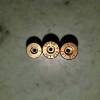When I first got into the round, I bought a couple of cases of the Speer Lawman ammo for practice, as it was supposed to mimic their Gold Dots. I also bought a case of their Gold Dots. Back then, 357SIG was still fairly cheap, and the exact same price as 40 S&W when bought by the case. Right around $250/1000 for the Lawman.
I really didnt reload for it initially, mainly due to the basically caliber-specific 357SIG bullets being expensive, and I was only paying a dollar more a 50 round box for factory ammo by the case. Once the factory ammo took off, and it became more economical to load it, I switched over to doing that. I made out like a bandit when I decided to get out of the caliber when things really got silly, and more than doubled my money on the unopened cases of ammo when I sold them.
You cant normally use most 9mm bullets with the round when you reload, as the shape of the bullet wont allow proper OAL. The closest "9mm" bullet that comes close to the shape of the 357SIG bullet, is the 147 grain bullet. The shape is about the same, with the ogive more forward. I never had good luck with accuracy loading the 147's in the 357SIG though.
Most of my all of my brass was Speer, from the Lawman that Id shot. Never had an issue with it. Never noticed there was a problem with the primer pockets, ot that the flash holes were undersized They all decapped and reprimed without issue. At least I never noticed that something might be amiss. The same cases were reloaded a good number of times too.
Ive been using Hornady dies for a long time now and prefer them over the RCBS. Maybe their decapping pins are smaller, and the flash holes werent an issue.
The load I was using at the time, was a mimic of the factory loading. A 125 grain bullet over 13.0 grains of AA #9, which was the recommended load at the time. It was a compressed load too, which helped with the neck tension issues that the round can have. With the compressed load, there was no chance of bullet setback.
I havent been shooting/using 357SIG for about a decade now. Are you still seeing the smaller flash holes in the Speer brass?
I just remembered while writing this that I pulled down a box of 50 357SIG that Id found a week or two back in the cabinet, that Id loaded with 147 grain Gold Dots back around 2007. The cases were still in the trash bin just now, and I just decapped them using a set of Hornady 45acp dies. Both rounds I grabbed decapped and felt normal doing so.
Looks like I had some Federal brass in the mix as well. The 9mm was in the trash too and just there for comparison. The Federal flash hole looks like it "might" be a tad larger, but the 9mm and Speer case look the same to me. And actually, they all look pretty close.
The only thing that looks a little weird with the Speer case is, the flash hole almost looks like its "rolled out" a little around the edges. So maybe back when it was first reloaded, the flash hole was slightly smaller, and the decapping pin rolled it out as it went through. Dont know. As I said before, I never noticed anything wrong when I was loading them and they all sized up and decapped without issue, and all those cases were reloaded and shot, numerous times, so if the FH size was "something", it didnt seem to matter when I shot them.
View attachment 880592


